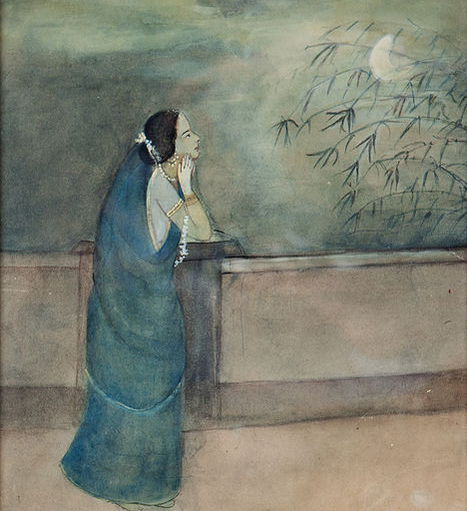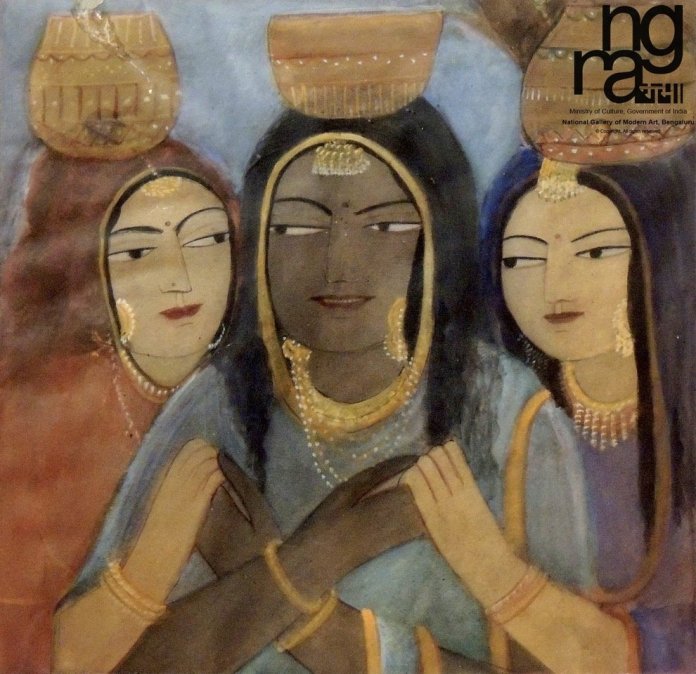Sunayani Devi
"Her pictures have no design for they have grown. Unbroken and unwavering is the flow of the lines, for no hesitation deflects them from the course they take as they wellforth out of her very nature; they surge in grave tranquillity and clasp groups and figures; they are forceful and languid, self-asserting and full of surrender; their curvature is the same which the passing breeze gives to the heavy ears of corn; all the warmth and light which surrounds ripe fields shines forth from these lines"
These were the words used by Stella Kramsich, her ultimate champion,introducing Sunayani Devi’s art to the world.
Sunayani Devi, better known as the daughter of the Tagore family had more claim to famethan just being a member of that aristocraticfamily. She has been acknowledged by many art historians as being the first Indian woman modern artist who signed her paintings. She also gained public recognition, and her work was a part of the exhibition of the Society of Oriental Art held in Calcutta in 1922, which also showcased the works of Klee, Kandinsky and other Bauhaus artists.
She grew up with her brother Abanindranath. At that time,he was the leader of the nationalist art movement in India, which eventually led him to start the very popular ‘Bengal school’. However, she took to art quite late in life, at the age of thirty. Nevertheless, she created a space for herself within the world of art, which was independent of the Tagore family.
As a self-taught artist, she would often observe her brothers experimenting with various painting techniques, like the wash technique, which did influence her as well.But she went on to create her own style. She is known to have maintained a strict regime, whereby, she started her day at eight in the morning until midday, and then from three until four-thirty. She grew up around the ‘Bengal Renaissance’, so, it should have been an obvious influence on her work. Ironically, the most fascinating part of her work was the fact, that none of her work was inspired by the Bengal school, and that’s what made her art so significant in itscontribution to the modern art in India. Her two main inspirations as many art historians have observed were: village clay dolls that often adorned urban homes and Kalighat pats. She was the first artist in India to go to village Pata art for her inspiration, which is reflectedin her art,by way of the half-closed, elongated eyes, which portrays the divine beingsand the fish-shaped eyes with long eyebrows for women and royalty.These finer details arewhat made her art so unconventional and so significant in its contribution. It is said that her work was influenced by Raja Ravi Varma prints and the ‘hieratic quality’ of ancient Jain paintings.
She brought the folk art to the modern Indian painting scene, which later went on to influence the famous artist, Jamini Roy.Art historians observed that the style developed by Roy and Sunayani Devi shared similarities with the intellectual approach of European modernists, such as Picasso or Gauguin.Yet, it is difficult to determine whether these international art movements influenced them in any way. Some historians have said that, ‘rather than describing her as a folk painter, we should view her as a genuine naïve painter who used folk motifs with immense charm and feeling.’
Her work certainly took her far and wide. Reputed art historian Stella Kramrisch publicized her work in the German art magazine, Der Cicerone in 1925.In 1927, she was invited to exhibit at the Women’s International Art Club in London. Her work brought her a lot of recognition.
In a letter to her grandson, she writes, ‘most of the paintings I have seen in my dreams – after seeing them, I have put them down’.This tells us that her art depicted her innermost private life. She brought out the ‘domesticity’ of theIndian woman - their solitude and their pensive moods. She represented the life of the Indian woman quite aptly in her work - be it “Radha", "Village Maid", "The Votress", or "Mother". Indian painting perhaps, for the first time got to see a painting through a ‘female gaze’. She has left behind a legacy which is testimony to the fact, that it is never too late to create art that will be immortal.
 Government of India
Government of India







